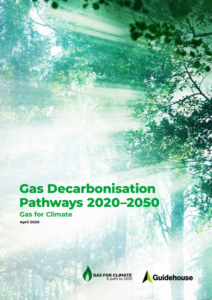The newly launched report “Gas Decarbonisation Pathways 2020–2050” presents the development of gas decarbonization pathways from 2020 to 2050 and identifies what investments and actions are required across the energy system.
The EU aims to make Europe a climate neutral continent by 2050, and the European Commission proposed an EU Climate Law that would make this a legally binding objective. The European Commission’s Green Deal concludes that greenhouse gas emission reduction goals for 2030 need to be increased from 40% to either 50% or 55% to achieve this goal.
For the EU to achieve a 55% greenhouse gas emission reduction by 2030 and climate neutrality by mid-century, renewable molecules, renewable electricity, and a more integrated use of the electricity grids and the gas grids are required. Renewable and low carbon gases and gas infrastructure have an important role to play to cost-effectively achieve a reliable net-zero EU energy system by 2050.
Moreover, the study develops gas decarbonization pathways from 2020 to 2050, and identifies what investments and actions are needed across the energy system along the way.
Also, it analyses individual decarbonisation pathways for the demand side (buildings, industry, transport, power generation) that are matched with scale-up pathways for biomethane and hydrogen. The specific pathways are blended in three overall pathway scenarios that also include implications for gas infrastructure:
- Current EU Trends Pathway: Expected developments during the period from 2020 to 2030 based on full implementation of the existing EU 2030 climate and energy policies.
- Accelerated Decarbonisation Pathway: The supply and demand of renewable electricity, hydrogen, and biomethane will accelerate by grasping innovations and investment opportunities.
- Global Climate Action Pathway: The rest of the world follows Europe’s example in reducing greenhouse gas emissions in line with climate science and the Paris Agreement
In the meantime, the study highlighted the importance of shipping adopting LNG as a marine fuel, adding that “Ocean shipping rapidly moves towards the use of LNG (liquefied natural gas) as a fuel, paving the way for bio-LNG and possibly ammonia.”

Many future fuel technologies are being considered for the shipping sector. Based on its analysis, Navigant envisions that all existing diesel and marine fuelled vessels will be replaced mainly by bio-LNG and battery electric vessels by 2050, avoiding the need to develop additional production routes for more expensive or scarce biodiesel. However, other fuel options could also become relevant, such as green hydrogen and synthetic ammonia.
Overall, to learn more about decarbonization click herebelow
































































